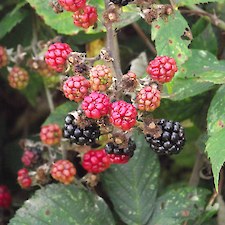
Blackberry
Common name: Blackberry
Botanical name: Rubus fructicosus agg
Management programme: Sustained Control
Blackberry came to New Zealand with the early British pioneers to give them a taste of home – many of the plants ended up in gardens where people could pick the fruits and make blackberry pie. This plant is native to Northern Europe.
Why is it a pest?
- Blackberry can invade poorly maintained pasture, reducing area for grazing and breaking fences that it grows over.
- Big problem for pasture and forestry – both native and production.
- Sheep can also become entangled in it, reducing value of wool and causing harm to the animals.
- Blackberry prevents regeneration of native bush where bush margins are infested.
- In forestry it can hamper management operations as it happily takes over the understorey and creates access barriers for pruning and felling.
- It can also restrict access to recreational areas and provide habitat for animal pests such as rabbits.
- Seed is dispersed by people, birds, water, soil movement, machinery and animals.
Where is it found?
Blackberry is well established throughout the Bay of Plenty.
Blackberry grows almost anywhere where there is enough light, from pasture to pine forests. At-risk areas are pasture, exotic forests, bush edges, open areas, roadsides, sand dunes, shrubland, wetlands, and streambanks.
What does it look like?
- This is a scrambling perennial that has stems that tangle as they grow out and arch from the main trunk. Stems can grow to 8m in length and it can reach up to 2m in height.
- Stems have very sharp backward pointing thorns.
- Root has a well-defined crown just under the soil surface which produces several suckers.
- Leaves have 3–5 lobes with toothed edges and usually 5–7 oval leaflets, with prickly stalks and mid-ribs.
- White or pink flowers, 2-3 cm in diameter, each with five petals and many stamens followed by black berries.
- Edible berries are red at first and purple-black when ripe.
- Leaves die back over winter and reshoot in spring.
What are the rules?
Sustained Control
Blackberry is a Sustained Control pest. Sustained Control pests are well established in the region and preventing the spread is no longer a realistic objective. Management focuses on reducing general impacts of the pest. Landowners/ occupiers are responsible for the control of these pest species on their land. Council may enforce control.
Rules require land occupiers to destroy any blackberry on their properties that is within 10m of any property boundary where the adjoining occupier is also controlling the pest plant.
How do you get rid of it?
- Small numbers of small plants can be grubbed (manually dug out) so long as the crown of the plant is removed.
- Spray during late spring and summer. Thorough coverage is important.
Recommended:
- Spray with metsulfuron-methyl with knapsack or CDAX unit 5g per 10L of water.
- With handgun use 35g per 100L water.
- Always add a penetrant to the spray mix (use 10ml for every 10L water).
To minimise damage to pasture:
- Spray with triclopyr.
- With knapsack or CDAX unit use 60ml per 10L water.
- With handgun use 300ml per 100L water.
Maintaining a vigorous, dense pasture sward and good fertility will help prevent blackberry establishing.
Note:
- Any rotary slashing should be left until the canes are completely dead.
- Burning is not necessary.
- Regular follow-up treatment may be necessary for some years until the seed bank in the soil is exhausted.
- Spray at least 4 months before replanting with other species.
- Recovers quickly after slashing or grazing, rhizomes are difficult to dig out and always regrow.
- Native species will usually overtop blackberry if there is good canopy growth.
CAUTION: When using any herbicide or pesticide, PLEASE READ THE LABEL THOROUGHLY to ensure that all instructions and directions for the purchase, use and storage of the product, are followed and adhered to.
Read more on pest control advice, information and regulations.
Images







